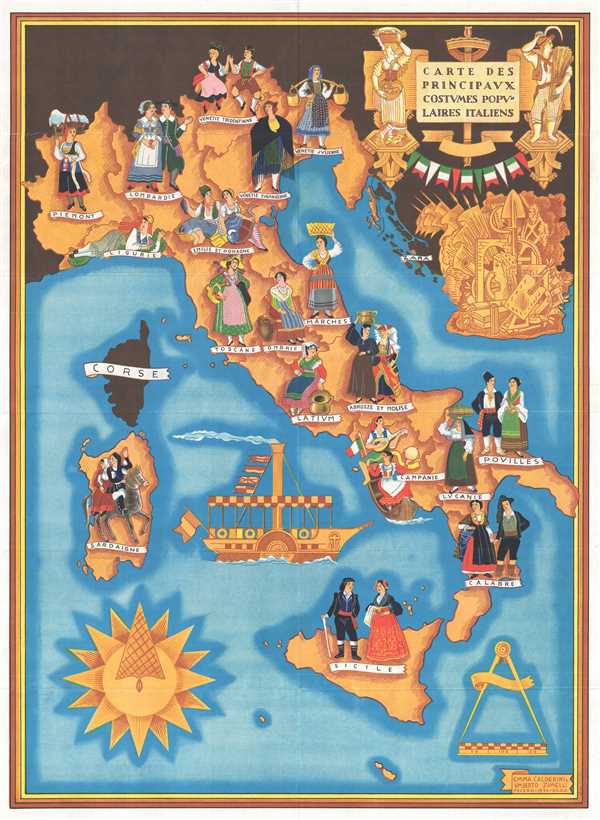Digital Image: 1934 Calderini and Zimelli Pictorial Map of Italy and Italian Folk Costumes
CostumesItaliens-calderinizimelli-1934_d
Title
1934 (dated) 25 x 18.25 in (63.5 x 46.355 cm) 1 : 2214000
Description
FOR THE ORIGINAL ANTIQUE MAP, WITH HISTORICAL ANALYSIS, CLICK HERE.
Digital Map Information
Geographicus maintains an archive of high-resolution rare map scans. We scan our maps at 300 DPI or higher, with newer images being 600 DPI, (either TIFF or JPEG, depending on when the scan was done) which is most cases in suitable for enlargement and printing.
Delivery
Once you purchase our digital scan service, you will receive a download link via email - usually within seconds. Digital orders are delivered as ZIP files, an industry standard file compression protocol that any computer should be able to unpack. Some of our files are very large, and can take some time to download. Most files are saved into your computer's 'Downloads' folder. All delivery is electronic. No physical product is shipped.
Credit and Scope of Use
You can use your digial image any way you want! Our digital images are unrestricted by copyright and can be used, modified, and published freely. The textual description that accompanies the original antique map is not included in the sale of digital images and remains protected by copyright. That said, we put significant care and effort into scanning and editing these maps, and we’d appreciate a credit when possible. Should you wish to credit us, please use the following credit line:
Courtesy of Geographicus Rare Antique Maps (https://www.geographicus.com).
How Large Can I Print?
In general, at 300 DPI, you should at least be able to double the size of the actual image, more so with our 600 DPI images. So, if the original was 10 x 12 inches, you can print at 20 x 24 inches, without quality loss. If your display requirements can accommodate some loss in image quality, you can make it even larger. That being said, no quality of scan will allow you to blow up at 10 x 12 inch map to wall size without significant quality loss. For more information, it is best consult a printer or reprographics specialist.
Refunds
If the high resolution image you ordered is unavailable, we will fully refund your purchase. Otherwise, digital images scans are a service, not a tangible product, and cannot be returned or refunded once the download link is used.
Cartographer S
Emma Calderini (February 13, 1899 - March 5, 1975) was an Italian costume designer and historian of folk costume. He is also known for his participation in numerous theatrical productions and collaboration with cinema and television productions and numerous women's magazines. Calderini studied at the Scuola Normale di Ravenna and at the Academy of Fine Arts in Ravenna. He began his career at age twenty, when he finished his first work for Grazia, Mood, and Lidel. In 1922, Calderini moved to Milan and continued to expand his business by working with more fashion magazines. In 1925, Calderini began his career as a costume designer, working on several productions for the Agrigento theater. Calderini published his most famous work Il Costume Popolare in Italia in 1935. In publishing this work, Calderini garnered enough attention that he was given the task of reorganizing the Ethnographic Museum of Villa d'Este in Tivoli. During World War II, Calderini worked on a handful of films and after the war helped to found several new theatrical companies. In 1951 he was a consultant for costumes at the Center of Arts and Costume at Palazzo Grassi in Venice. More by this mapmaker...
Umberto Zimelli (May 4, 1898 - November 6, 1972) was an Italian designer, illustrator, painter, and ceramicist. He graduated from the School of Art of Forlì and attended the Academy of Fine Arts in Ravenna. In 1920 began producing cover for the magazine La Piè and in 1921 he first exhibited his oils, tempera, and drawing at the Lyceum in Milan. In 1924, Zimelli moved to Milan and taught decoration at the Mantegazza professional school from 1927 through 1933 and then taught professional design and decorative composition in the schools of the Umanitaria Society of Milan from 1932 until 1943. He also taught design, decorative composition, and wrought iron at the Higher Institute for the Artistic Industries in the Villa Reale of Monza from 1933 until 1943. He was the artist for the Italian National Tourism Agency's gastronomic, wine, and traditional costume maps of Italy. He illustrated covers for various authors and edited catalogs and advertising leaflets for exhibitions. After World War II he gave up teaching and became Director for the Lombardy Delegation of the National Organization of Crafts and Small Industries and held that post until 1967. Learn More...

